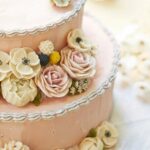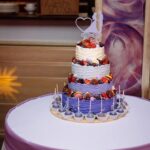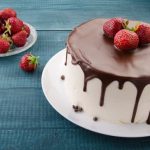Are you wondering how do you make chocolate decorations for cakes? Chocolate decorations can elevate the look and taste of a cake, adding a touch of sophistication and creativity. The versatility of chocolate allows for endless possibilities, making it an essential component in cake decorating. Whether you’re a baking enthusiast or a professional pastry chef, mastering the art of creating chocolate decorations can take your cake decorating skills to the next level.
Chocolate decorations are not only visually appealing but also add depth and richness to the flavor profile of a cake. From elegant curls and delicate shards to intricate shapes and designs, chocolate offers a wide range of options for customizing cakes for any occasion. The ability to hand-pipe, mold, or use chocolate transfers provides endless opportunities for creativity in cake decorating.
Choosing the right type of chocolate is crucial when making decorations for cakes. Different types of chocolate have varying levels of sweetness, bitterness, and melting points. Understanding the characteristics of each type of chocolate is essential in achieving the desired effect for your decorations. By selecting high-quality chocolate that complements the flavor of the cake, you can enhance the overall aesthetic and taste experience.
In this article, we will explore everything you need to know about making chocolate decorations for cakes, from choosing the right chocolate to troubleshooting common issues. We will cover the tools and materials needed, techniques for creating various shapes and designs, as well as tips on properly placing and arranging chocolate decorations on cakes.
Whether you’re looking to enhance a simple homemade cake or create show-stopping desserts for special occasions, mastering the art of making chocolate decorations will undoubtedly impress your friends, family, and clients alike.
Types of Chocolate for Decorations
When it comes to making chocolate decorations for cakes, choosing the right type of chocolate is crucial. There are various types of chocolate that can be used to create beautiful and delicious decorations, each with its own unique characteristics and flavor profile.
Dark Chocolate
Dark chocolate is a popular choice for making chocolate decorations due to its rich and intense flavor. It also has a higher cocoa content, which makes it ideal for creating intricate designs and shapes. When using dark chocolate for decorations, it’s essential to temper the chocolate properly to achieve a shiny and smooth finish.
Milk Chocolate
Milk chocolate is another excellent option for creating decorations, especially if you want a slightly sweeter flavor profile. Keep in mind that milk chocolate has a lower cocoa content, so it may not hold its shape as well as dark chocolate. However, it is still suitable for simpler designs and can add a creamy texture to your cake decorations.
White Chocolate
White chocolate can add a touch of elegance to your cake decorations with its creamy and sweet flavor. While technically not classified as true chocolate because it doesn’t contain cocoa solids, white chocolate can still be used to create beautiful decorations such as swirls, curls, and drizzles.
When selecting the type of chocolate for your cake decorations, consider the overall flavor profile of your cake and choose a type of chocolate that complements it. Whether you opt for dark, milk, or white chocolate, each offers its own unique benefits when creating stunning and delectable decorations.
Understanding the differences between these types of chocolates will allow you to make an informed decision when preparing your next batch of delightful cake embellishments.
Tools and Materials Needed
To create stunning chocolate decorations for cakes, it is essential to have the right tools and materials. Here is a list of specific items that you will need to get started:
1. Good Quality Chocolate: The type of chocolate you use will greatly impact the final result of your decorations. It is crucial to choose high-quality chocolate, whether it be dark, milk, or white chocolate, as this will ensure a smooth texture and rich flavor in your decorations.
2. Double Boiler or Microwave: Melting chocolate properly is key to successful decoration making. A double boiler is the preferred method for melting chocolate as it allows for gentle and even heat distribution. Alternatively, a microwave can be used, but extra care must be taken to avoid scorching the chocolate.
3. Piping Bags and Tips: When creating intricate designs and shapes with chocolate, piping bags and tips are indispensable tools. These allow for precise control when hand-piping decorations onto parchment paper or directly onto cakes.
4. Chocolate Molds: Using molds can help achieve consistent shapes and designs for your chocolate decorations. There are a variety of molds available in different shapes and sizes, allowing for endless possibilities when decorating cakes.
5. Chocolate Transfer Sheets: These sheets feature colorful designs and patterns that can be transferred onto melted chocolate. Using transfer sheets adds an element of sophistication to your cake decorations without requiring complex artistic skills.
By having these tools and materials at your disposal, you can explore myriad techniques for creating beautiful chocolate decorations for cakes that will impress everyone who lays eyes on them.
Preparation
Melting chocolate is a crucial step in the process of creating chocolate decorations for cakes. It is important to melt the chocolate properly to achieve the right consistency and texture for shaping and piping. In this section, we will provide a step-by-step guide on how to melt chocolate for decorations, as well as tips on avoiding common mistakes.
Choosing the Right Chocolate
Before melting your chocolate, it is essential to choose the right type of chocolate for your decorations. Different types of chocolate, such as dark, milk, and white chocolate, have varying melting points and textures. For example, dark chocolate requires a higher melting temperature compared to milk and white chocolate. Understanding the characteristics of each type of chocolate will help you achieve the desired result for your decorations.
Step-by-Step Guide
To begin melting your chocolate, chop it into small, evenly sized pieces to ensure even melting. Place the chopped chocolate in a microwave-safe bowl or use a double boiler to melt it gently over simmering water. Stir the chocolate occasionally to ensure that it melts evenly and does not burn. It is important to keep an eye on the temperature of the chocolate, as overheating can cause it to seize and become unusable for decorations.
Avoiding Common Mistakes
One common mistake when melting chocolate is introducing moisture into the process, which can cause the chocolate to seize and become lumpy. It is important to ensure that all utensils are dry and free from any moisture before coming into contact with the melted chocolate. Additionally, overheating the chocolate can lead to a gritty texture or burnt flavor. By following these steps and being mindful of potential mistakes, you can successfully melt chocolate for creating beautiful decorations for cakes.
By mastering the art of melting chocolate for decorations, you will have a solid foundation for creating stunning edible embellishments that will elevate any cake design.
Making Chocolate Shapes and Designs
When it comes to creating chocolate decorations for cakes, the possibilities are endless. From delicate chocolate curls to intricate molded designs, there are numerous ways to add a touch of elegance and creativity to your cake. Here are some techniques for making stunning chocolate shapes and designs:
1. Hand-Piping: Hand-piping is a classic technique used to create intricate designs with melted chocolate. By using a piping bag or plastic squeeze bottle, you can hand-pipe shapes such as swirls, flowers, and letters directly onto parchment paper or acetate sheets. Once the chocolate has set, carefully peel off the shapes and use them to adorn your cake.
2. Molded Chocolate: Using chocolate molds allows you to create three-dimensional shapes like hearts, stars, or even animals. Simply melt your preferred type of chocolate, pour it into the molds, and allow it to set in the refrigerator. Once hardened, carefully remove the chocolates from the molds and arrange them on top of your cake for a professional look.
3. Chocolate Transfers: Chocolate transfers are pre-made designs printed on acetate sheets that can be transferred onto a cake surface. These transfers come in a variety of patterns and images, making them an easy way to add detailed decorations without any freehand work.
As you experiment with different techniques for making chocolate shapes and designs, remember that practice makes perfect. Don’t be afraid to try out new ideas and push the boundaries of your creativity when it comes to decorating cakes with chocolate.
- Hand-Piping
- Molded Chocolate
- Chocolate Transfers
Decorating Cakes With Chocolate Decorations
When it comes to decorating cakes, chocolate decorations can truly elevate the overall appearance and appeal of a dessert. The rich and luxurious look of chocolate can take a plain cake to the next level, adding a touch of elegance and sophistication. Whether you are making a simple birthday cake or an elaborate wedding cake, chocolate decorations offer endless possibilities for creativity and innovation.
To decorate a cake with chocolate, you will need the right tools and materials. Here is a list of essential items that you will need:
- High-quality chocolate: Choose the type of chocolate based on your desired effect. Dark, milk, and white chocolate all offer different flavors and colors that can be used to create unique decorations.
- Piping bags: These are essential for piping melted chocolate onto cakes to create intricate designs.
- Chocolate molds: Molds come in various shapes and sizes and are perfect for creating uniform and professional-looking decorations.
- Chocolate transfers: These are pre-printed designs that can be transferred onto cakes using melted chocolate.
- Offset spatula: This tool is useful for spreading melted chocolate evenly across molds or transfer sheets.
Once you have gathered all the necessary tools and materials, the next step is to prepare the melted chocolate for decorating. You can use either a double boiler or microwave to melt your chocolate. Here’s how to do it:
- Chop your chocolate into small, uniform pieces to ensure even melting.
- Place the chopped chocolate into a heatproof bowl.
- If using a double boiler, bring a pot of water to a simmer then place the bowl of chopped chocolate on top of the pot, ensuring that no water gets into the bowl.
- Stir occasionally until the chocolate is completely melted.
- If using a microwave, place the chopped chocolate in a microwave-safe bowl and heat in 15-second intervals, stirring between each interval until fully melted.
Once your chocolate is properly melted, you can then proceed with creating various shapes and designs to decorate your cake. You can pipe intricate designs directly onto the cake using piping bags filled with melted chocolate or use molds to create three-dimensional shapes such as flowers, hearts, or letters. Another option is to use pre-made chocolate transfers that can be carefully placed onto the surface of your cake.
Decorating cakes with chocolate decorations truly allows for endless creativity and innovation when it comes to cake design. By following these tips and techniques, you can impress others with your exquisite creations while adding an extra layer of flavor and visual appeal to any dessert.
Storing Chocolate Decorations
After spending time and effort creating beautiful chocolate decorations for cakes, it is important to know how to store them properly to maintain their quality and appearance. Storing chocolate decorations requires a few essential steps to ensure that they stay in perfect condition until they are ready to be used. The keyword “how do you make chocolate decorations for cakes” doesn’t just involve the process of making the decorations, but also taking care of them afterwards.
The first step in storing chocolate decorations is to ensure that they are completely dry before attempting to store them. Placing wet or damp chocolate designs in storage will cause them to become soft and lose their shape. Allow the chocolate decorations to air-dry at room temperature until they are completely hardened before proceeding with the storage process.
Once the chocolate decorations are fully dry, they should be stored in an airtight container. This will help prevent exposure to moisture, which can cause the chocolate to melt or become sticky. Additionally, storing the container in a cool, dark place such as a pantry or cupboard will protect the decorations from heat and sunlight, preserving their appearance and preventing them from melting.
It is important not to stack or overcrowd the chocolate decorations within the container, as this can lead to breakage or damage. To keep delicate designs intact, layering sheets of parchment paper between each decoration can provide additional protection. By following these guidelines for storing chocolate decorations, you can ensure that your hard work pays off when it’s time to adorn your cakes with exquisite edible artistry.
Troubleshooting Common Issues
Making chocolate decorations for cakes can be a fun and creative way to take your cake decorating skills to the next level. However, there are some common issues that may arise when working with chocolate. Understanding how to troubleshoot these issues will help ensure that your chocolate decorations turn out beautifully every time.
One common issue when making chocolate decorations is the chocolate seizing or becoming lumpy and unworkable. This usually happens when moisture comes into contact with the chocolate, causing it to harden and clump together. To avoid this problem, make sure all of your tools and utensils are completely dry before using them, and be cautious when adding any liquid flavorings to the chocolate.
Another issue that can arise is when the chocolate decorations don’t release from their molds properly, resulting in broken or misshapen designs. To prevent this, properly prepare your molds by greasing them with a thin layer of oil or non-stick spray before pouring in the melted chocolate. Additionally, make sure to give the chocolate enough time to set and harden completely before attempting to remove it from the mold.
It’s also common for chocolate decorations to lose their shine and develop a dull or cloudy appearance over time. This could happen if the decorations are exposed to fluctuating temperatures or humidity levels. To maintain the glossy finish of your chocolate decorations, store them in a cool, dry place away from direct sunlight and extreme temperature changes.
These troubleshooting tips are essential for anyone looking to perfect their chocolate decorating skills. By being aware of these common issues and knowing how to address them effectively, you’ll be able to create stunning chocolate decorations that will impress everyone who sees them.
| Common Chocolate Decoration Issues | Troubleshooting Tips |
|---|---|
| Chocolate seizing/ becoming lumpy | Ensure all tools are dry / avoid adding liquid flavorings directly |
| Chocolate not releasing from molds properly | Properly grease molds / allow enough cooling time before removing |
| Loss of shine or cloudiness on decorations | Store in cool, dry place away from sunlight and extreme temperatures |
Conclusion
In conclusion, mastering the art of making chocolate decorations for cakes can truly take your cake decorating skills to a whole new level. The versatility and creativity that chocolate decorations bring to cake decorating allows for endless possibilities in creating unique and visually stunning cakes. By learning the techniques and tips for making chocolate decorations, you can elevate any ordinary cake into a work of art that will impress anyone who sees or tastes it.
As you continue to practice and experiment with different types of chocolate, tools, and techniques, you will be able to showcase your chocolate decorating skills with confidence. Whether you are hand-piping intricate designs, molding detailed shapes, or using chocolate transfers, the key is to keep practicing and refining your skills. With dedication and patience, you can become an expert in creating beautiful chocolate decorations that will make your cakes stand out.
So go ahead and show off your chocolate decorating skills with pride. Whether it’s for special occasions or everyday treats, your beautifully crafted chocolate decorations will surely make a lasting impression on anyone who enjoys your delicious creations. Keep exploring new ideas and techniques, and don’t be afraid to let your creativity shine through as you continue to perfect the art of making chocolate decorations for cakes.

Welcome to my blog about home and family. This blog is a place where I will share my thoughts, ideas, and experiences related to these important topics. I am a stay-at-home mom with two young children. I hope you enjoy reading it! and may find some helpful tips and ideas that will make your home and family life even better!





